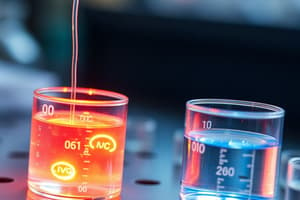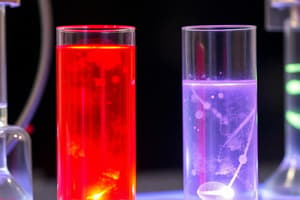Podcast
Questions and Answers
What is the primary consideration when selecting a wavelength for analyzing an analyte?
What is the primary consideration when selecting a wavelength for analyzing an analyte?
- The color of the analyte
- Ensure strong absorption of the analyte at the selected wavelength (correct)
- The size of the sample container
- The temperature of the environment
Which factor is NOT relevant when selecting a wavelength for spectrophotometric analysis?
Which factor is NOT relevant when selecting a wavelength for spectrophotometric analysis?
- Presence of interfering species
- Instrument limitations
- Personal preference of the analyst (correct)
- Absorbance of the analyte
When dealing with a spectrum that has broad peaks, what should be prioritized?
When dealing with a spectrum that has broad peaks, what should be prioritized?
- The average absorbance across all peaks
- The first peak encountered in the spectrum
- The most prominent or specific peak related to the analyte (correct)
- A peak with minimal absorbance
What wavelength range is typically covered by UV-Vis spectrophotometers?
What wavelength range is typically covered by UV-Vis spectrophotometers?
What should be avoided to minimize the impact of stray light on absorbance measurements?
What should be avoided to minimize the impact of stray light on absorbance measurements?
What characterizes a galvanic cell?
What characterizes a galvanic cell?
In an electrochemical cell, which process occurs at the anode?
In an electrochemical cell, which process occurs at the anode?
Which part of an electrochemical cell balances charges at the electrodes?
Which part of an electrochemical cell balances charges at the electrodes?
What is the main purpose of an electrolytic cell?
What is the main purpose of an electrolytic cell?
What is a defining feature of voltaic cells?
What is a defining feature of voltaic cells?
Which electrode serves as the negative terminal in a galvanic cell?
Which electrode serves as the negative terminal in a galvanic cell?
Which of the following statements accurately describes redox reactions?
Which of the following statements accurately describes redox reactions?
In the representation of an electrochemical cell, what does a single line ( | ) indicate?
In the representation of an electrochemical cell, what does a single line ( | ) indicate?
What is the primary role of the monochromator in a spectrometer?
What is the primary role of the monochromator in a spectrometer?
Why is it essential to select the appropriate wavelength when using a spectrophotometer?
Why is it essential to select the appropriate wavelength when using a spectrophotometer?
What could potentially skew absorbance readings during spectrophotometric analysis?
What could potentially skew absorbance readings during spectrophotometric analysis?
What is the purpose of the detector in a spectrometer?
What is the purpose of the detector in a spectrometer?
Which application of spectrochemical methods focuses on ensuring the safety of consumable products?
Which application of spectrochemical methods focuses on ensuring the safety of consumable products?
What does the Beer-Lambert Law primarily describe?
What does the Beer-Lambert Law primarily describe?
What is one disadvantage of spectrochemical methods?
What is one disadvantage of spectrochemical methods?
What must be understood before selecting the appropriate wavelength during a spectrophotometric analysis?
What must be understood before selecting the appropriate wavelength during a spectrophotometric analysis?
What is the primary role of the working electrode in voltammetric techniques?
What is the primary role of the working electrode in voltammetric techniques?
Which voltammetric technique involves a linear increase in voltage with time?
Which voltammetric technique involves a linear increase in voltage with time?
In which practical application is voltammetry NOT typically used?
In which practical application is voltammetry NOT typically used?
What is the function of the reference electrode in electrochemical measurements?
What is the function of the reference electrode in electrochemical measurements?
Which of the following techniques is particularly sensitive for trace metal analysis?
Which of the following techniques is particularly sensitive for trace metal analysis?
Which component of a voltammetric cell allows current to flow and completes the circuit?
Which component of a voltammetric cell allows current to flow and completes the circuit?
What does differential pulse voltammetry primarily improve in measurements?
What does differential pulse voltammetry primarily improve in measurements?
Spectrochemical methods mainly involve the interaction of what with matter?
Spectrochemical methods mainly involve the interaction of what with matter?
What principle does UV-Vis spectroscopy rely on to relate absorbance to concentration?
What principle does UV-Vis spectroscopy rely on to relate absorbance to concentration?
Which of the following is a limitation of Atomic Absorption Spectroscopy (AAS)?
Which of the following is a limitation of Atomic Absorption Spectroscopy (AAS)?
What is the primary application of fluorescence spectroscopy?
What is the primary application of fluorescence spectroscopy?
How does fluorescence spectroscopy detect emitted light?
How does fluorescence spectroscopy detect emitted light?
What factor does NOT influence the absorbance in UV-Vis spectroscopy according to the Beer-Lambert Law?
What factor does NOT influence the absorbance in UV-Vis spectroscopy according to the Beer-Lambert Law?
What type of sample states does Atomic Absorption Spectroscopy (AAS) analyze?
What type of sample states does Atomic Absorption Spectroscopy (AAS) analyze?
What advantage does fluorescence spectroscopy offer compared to other methods?
What advantage does fluorescence spectroscopy offer compared to other methods?
Which application is NOT commonly associated with Atomic Absorption Spectroscopy (AAS)?
Which application is NOT commonly associated with Atomic Absorption Spectroscopy (AAS)?
What does a peak in the spectrum indicate?
What does a peak in the spectrum indicate?
Why is using λmax advantageous when measuring absorbance?
Why is using λmax advantageous when measuring absorbance?
For a blue solution like Cu²⁺ in ammonia, where is λmax typically found?
For a blue solution like Cu²⁺ in ammonia, where is λmax typically found?
What happens if measurements are taken at wavelengths away from the λmax?
What happens if measurements are taken at wavelengths away from the λmax?
In the example of Fe³⁺ ions with thiocyanate, at what wavelength is λmax found?
In the example of Fe³⁺ ions with thiocyanate, at what wavelength is λmax found?
Why is wavelength selection critical to calibration?
Why is wavelength selection critical to calibration?
Which effect is most likely when using absorbance values at wavelengths far from λmax?
Which effect is most likely when using absorbance values at wavelengths far from λmax?
What is a benefit of the linearity of the Beer-Lambert Law near λmax?
What is a benefit of the linearity of the Beer-Lambert Law near λmax?
Flashcards
Electrochemistry
Electrochemistry
A branch of chemistry that explores the relationship between chemical reactions and electrical energy.
Redox Reactions
Redox Reactions
Chemical reactions where electrons are transferred between substances.
Electrochemical Cells
Electrochemical Cells
Devices that convert chemical energy into electrical energy or vice versa.
Galvanic Cells (Voltaic Cells)
Galvanic Cells (Voltaic Cells)
Signup and view all the flashcards
Anode
Anode
Signup and view all the flashcards
Cathode
Cathode
Signup and view all the flashcards
Electrolytic Cells
Electrolytic Cells
Signup and view all the flashcards
Salt Bridge
Salt Bridge
Signup and view all the flashcards
Voltammetry
Voltammetry
Signup and view all the flashcards
Redox Potential
Redox Potential
Signup and view all the flashcards
Reversibility of Redox Reaction
Reversibility of Redox Reaction
Signup and view all the flashcards
Working Electrode
Working Electrode
Signup and view all the flashcards
Reference Electrode
Reference Electrode
Signup and view all the flashcards
Counter Electrode
Counter Electrode
Signup and view all the flashcards
Linear Sweep Voltammetry (LSV)
Linear Sweep Voltammetry (LSV)
Signup and view all the flashcards
Cyclic Voltammetry (CV)
Cyclic Voltammetry (CV)
Signup and view all the flashcards
λmax
λmax
Signup and view all the flashcards
Spectrometer
Spectrometer
Signup and view all the flashcards
Calibration
Calibration
Signup and view all the flashcards
Visible Spectrophotometer
Visible Spectrophotometer
Signup and view all the flashcards
λmax (Lambda max)
λmax (Lambda max)
Signup and view all the flashcards
Beer-Lambert Law
Beer-Lambert Law
Signup and view all the flashcards
Absorbance
Absorbance
Signup and view all the flashcards
Absorbance Spectrum
Absorbance Spectrum
Signup and view all the flashcards
Linearity of Beer-Lambert Law
Linearity of Beer-Lambert Law
Signup and view all the flashcards
Beer-Lambert Law
Beer-Lambert Law
Signup and view all the flashcards
Monochromator
Monochromator
Signup and view all the flashcards
Sensitivity
Sensitivity
Signup and view all the flashcards
Detector
Detector
Signup and view all the flashcards
Transmittance
Transmittance
Signup and view all the flashcards
Cuvette
Cuvette
Signup and view all the flashcards
Absorbance Spectrum
Absorbance Spectrum
Signup and view all the flashcards
UV-Vis Spectroscopy
UV-Vis Spectroscopy
Signup and view all the flashcards
Atomic Absorption Spectroscopy (AAS)
Atomic Absorption Spectroscopy (AAS)
Signup and view all the flashcards
Fluorescence Spectroscopy
Fluorescence Spectroscopy
Signup and view all the flashcards
Molar Absorptivity (ε)
Molar Absorptivity (ε)
Signup and view all the flashcards
Path Length (b)
Path Length (b)
Signup and view all the flashcards
Atomization
Atomization
Signup and view all the flashcards
Interference from Other Species
Interference from Other Species
Signup and view all the flashcards
Study Notes
Electrochemistry
- Electrochemistry studies the interplay between electrical energy and chemical reactions
- It's crucial for understanding how chemical reactions produce electricity and vice-versa
Key Concepts
- Redox Reactions: Essential to electrochemical processes; involve oxidation (loss of electrons) and reduction (gain of electrons)
- Electrochemical Cells: Devices transforming chemical energy into electrical energy (galvanic/voltaic cells) or using electrical energy to drive chemical reactions (electrolytic cells)
Electrochemical Cells (Galvanic)
- Galvanic cells produce electricity from spontaneous redox reactions.
- Typically consist of two electrodes (anode and cathode), often made of different metals, immersed in an electrolyte.
- The anode is where oxidation occurs; the cathode is where reduction occurs.
- A salt bridge connects the half-cells to maintain charge neutrality.
- Oxidation occurs at the anode (Red Cat An Ox)
Electrolytic Cells
- Electrolytic cells require an external energy source (e.g., a battery) to drive a nonspontaneous redox reaction.
- The electrodes in electrolytic cells are connected to the power source, driving the non-spontaneous reaction.
- The electrodes of an electrolytic cell can be placed in a single compartment containing the molten or aqueous electrolyte.
- Oxidation occurs at the anode; the electrode becomes the positive terminal
- Reduction occurs at the cathode; the electrode becomes the negative terminal
Electrode Potentials
- The potential difference between two electrodes determines the cell voltage.
Applications of Electrochemistry
- Batteries
- Corrosion prevention
- Electroplating
- Analytical techniques (e.g., pH measurements, ion concentration determination)
Potentiometry
- Measures the potential difference between a reference electrode and an indicator electrode without drawing current.
- Used for pH measurement and ion concentration determination.
- Standard Hydrogen Electrode (SHE), Silver/Silver Chloride Electrode (Ag/AgCl), and Calomel Electrode are common reference electrodes.
Voltammetry
- Measures current as a function of applied voltage.
- Provides information about redox behavior and concentration of analytes in a solution.
- Techniques include Linear Sweep Voltammetry (LSV), Cyclic Voltammetry (CV), Differential Pulse Voltammetry (DPV), and Square Wave Voltammetry (SWV).
- Cyclic voltammetry involves scanning the applied potential cyclically to study redox reactions, reversibility, and kinetics.
Spectrochemical Analysis
- UV-Vis Spectroscopy: Measures the absorption of ultraviolet and visible light by a sample. Based on the Beer-Lambert law.
- Atomic Absorption Spectroscopy (AAS): Measures light absorption by free atoms in the gaseous state.
- Fluorescence Spectroscopy: Measures the emission of light by a substance after absorbing electromagnetic radiation.
Practical Considerations
- Spectrometer calibration is necessary
- Select the optimal wavelength (λmax) for highest accuracy and sensitivity
- Overlap from other absorbing species must be minimized
- Instrument limitations should be considered
Studying That Suits You
Use AI to generate personalized quizzes and flashcards to suit your learning preferences.




